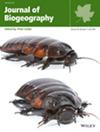Ecological and Anthropogenic Drivers of Red Fox (Vulpes vulpes) Abundance and Site Use Across the Contiguous USA
Abstract
Aim
Understanding species abundance and distribution is fundamental for conservation, particularly for widespread animals that influence ecosystem health and processes. Red foxes ( Vulpes vulpes ) are the most widely distributed mammalian carnivore globally, and provide many ecosystem services while also being a potential source of human-wildlife conflict. Determining drivers of red fox distributions is therefore important for human-wildlife coexistence and management.
Location
We analysed data from 4587 individual camera trap sites from 254 study arrays across the contiguous USA from a coordinated, multi-year camera trap survey (Snapshot USA).
Methods
We assessed the site use probability (using a Bayesian occupancy model at the 1 km scale) and local abundance (using a Bayesian N-mixture model at the 100 m scale) of red foxes. Specifically, we assessed the effects and relative importance of nine covariates we predicted would shape the distribution and abundance of red foxes.
Results
Our analyses revealed that the local abundance and site use probability of red foxes were influenced by the quadratic effect of impervious surfaces (highlighting a preference for an intermediate level at both fine and coarse scales), and a positive relationship with water availability. However, the local abundance and site use probability of red foxes varied relative to the detection rate of coyotes, the proportion of agricultural cover, and urban edge habitat. The relationship between red foxes and competitively dominant coyotes was complex, showing a positive association with coyotes at the 1 km scale (suggesting shared resource use) and a moderate negative association at the 100 m scale (suggesting competitive exclusion and resource partitioning).
Main Conclusions
Our results highlight how a generalist species, like red foxes, seeks out resources differentially at varying scales. Our findings highlight the complex interactions between red foxes and their environment, thus emphasising the importance of habitat features, especially urban development and water availability, in shaping their distribution and abundance.


 求助内容:
求助内容: 应助结果提醒方式:
应助结果提醒方式:


